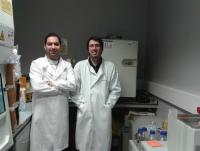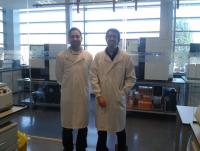As usual, please bear in mind that the first thing we want these researchers to do is to focus on life-extension research, so please give them some time to answer.

Cryoprotectant Research: Questions
#1
Posted 12 January 2012 - 11:51 PM
As usual, please bear in mind that the first thing we want these researchers to do is to focus on life-extension research, so please give them some time to answer.
#2
Posted 29 January 2012 - 12:48 AM
#3
Posted 02 February 2012 - 01:07 AM
#4
Posted 02 February 2012 - 09:24 PM
can't resist to say how great this sounds!sharing the results with the LongeCity community may prove beneficial because its members may find patterns and insights in our results that we would otherwise miss.
If from time to time you can post a picture of how you do the experiment, that may also help lots of members learn/understand/suggest/project themselves in such work
#5
Posted 03 February 2012 - 10:43 AM
If from time to time you can post a picture of how you do the experiment, that may also help lots of members learn/understand/suggest/project themselves in such work
I have to say that visually it doesn't look as exciting as it sounds. most of what we do is on small petri dishes and eppendorfs which look really dull. we could try to get some pictures of cells under the microscope, though, and post them -- these may look more exciting.
#6
Posted 10 February 2012 - 07:49 PM
also, thinking of revival effectiveness, there may be categories of value. perhaps a thawed organism would most benefit from DNA, mRNA, tRNA intactness, as compared with say membrane intactness, (others might possibly prefer membrane intactness) Thus prioritizing what you want to thaw right could guide the creation of the chemistry.
Ive read that melatonin preferentially accumulates at the nucleus, thus a cryopreservative molecule like a glycol attached to melatonin might measurably preserve the nucleus more effectively which sure sounds important or better.
memories are linked to mRNA production, thus the crypreservation of the "immediate protein environment going on" with mRNA might conserve some mood or beingness among the thawed creatures
As a rapid development approach, even if you just crypreserve a tardigrades, perhaps you could teach them to swim towards a particular color light, then show the ones with mRNA cryopreservative retained their learning more effectively. That would tell the humans there is a cryopreservative better at preserving memory.
Ive heard the chemical ethidium bromide intercalates with DNA, possibly there is a less forceful similar molecule, or possibly a generic very brief siRNA that would lazily reversibly glom mRNA making it more freezeproof.
Edited by treonsverdery, 10 February 2012 - 07:51 PM.
#7
Posted 15 February 2012 - 02:55 PM
I don't know if memories are linked to mRNA production. My understanding is that memories are linked to synapses. Do you have a reference on this?
#8
Posted 02 June 2012 - 10:20 PM
#9
Posted 07 July 2012 - 12:33 PM
Any news? difficulties so far, choices you made, etc.
we have only just started the project on July 1 because we were waiting for all the staff to be in place to begin. so we don't have much news at this stage. I can tell you that we are in the process of establishing a culture of endothelial cells in our lab and will then be trying different cryopreservation protocols on them. I would hope that by August or September we know a little bit more about how these cells behave and can give you an update with some results or information of how our experiments are going.
Cheers,
Joao Pedro
#10
Posted 12 October 2012 - 01:35 PM
The situation is that we will need to make a decision on which conditions to profile gene expression (i.e., which CPA(s), concentrations, times from exposure). As such, before we start using HUVECs, which are not as easy to cultivate as HeLa, we want to test different types and concentrations of CPA, so that when we start using HUVECs we will only need some minor adjustments. at the moment we are inclined to profile gene expression on cells exposed to Ethylene Glycol, because I think we know much less about its toxicity than DMSO. We're inclined to do this at different time points using a concentration that kills ~half the cells, but suggestions are welcomed.
Cheers,
Joao Pedro
#11
Posted 12 October 2012 - 07:24 PM
To rephrase and be sure we understand, you are now first planning to test the impact of Ethylene Glycol on gene expression profile in HeLa cells, to start with what works in order to make not-too big steps so that you ensure the quality of your work. You may try a few concentrations and times from exposures, so that we'll have a feeling and a good basis for further analysis. Is that right?
Then you plan to move to HUVECs when/if you are able to cultivate them correctly in the lab, and do the same, at least with one/a few points that was chosen based on HeLa results. Right?
If things work that far, then you plan to do other CPA's, doses, times from exposures. Don't hesitate to correct if I misunderstood. The clearer, the more useful it can be to have such open-science. Thank you!!!
Edited by AgeVivo, 12 October 2012 - 07:25 PM.
#12
Posted 18 October 2012 - 04:23 PM
Joao Pedro
#13
Posted 25 October 2012 - 03:41 AM
#14
Posted 03 December 2012 - 07:06 PM
Also, excuse my ignorance, but will you be testing M22 - the cryoprtectant used by 21st century medicine?
#15
Posted 09 December 2012 - 06:03 PM
#17
Posted 19 April 2013 - 03:32 PM
Cheers,
Joao Pedro
#18
Posted 21 April 2013 - 09:50 PM
#19
Posted 29 April 2013 - 05:17 PM
#20
Posted 29 April 2013 - 08:50 PM
The researchers might have a little to add as well.
#21
Posted 02 May 2013 - 11:23 AM
any... good or bad news? having a set of data that can be analysed at home may interest some future researcherswe hope to have the gene expression data next month. will let you know once we have the results.
#22
Posted 27 January 2014 - 10:10 PM
http://cryopreservation.org.uk/
On our website you can find a brief description of the project as well as some preliminary results:
http://cryopreservat...k/research.html
Specifically, we have the list of genes differentially expressed at 24 hours ( which is when most gene expression changes take place). We are now trying to interpret the results so we can write up and published this, so any ideas or suggestions are welcomed -- any genes that look particularly interesting?
Thanks,
Joao Pedro
#23
Posted 20 December 2015 - 08:49 PM
Here is the final paper on the research. A lot of quantitative information on gene expression. Ethylene glycol was not very toxic at 60% concentration after 2 hours of exposure.
Attached Files
2 user(s) are reading this topic
0 members, 2 guests, 0 anonymous users

















































